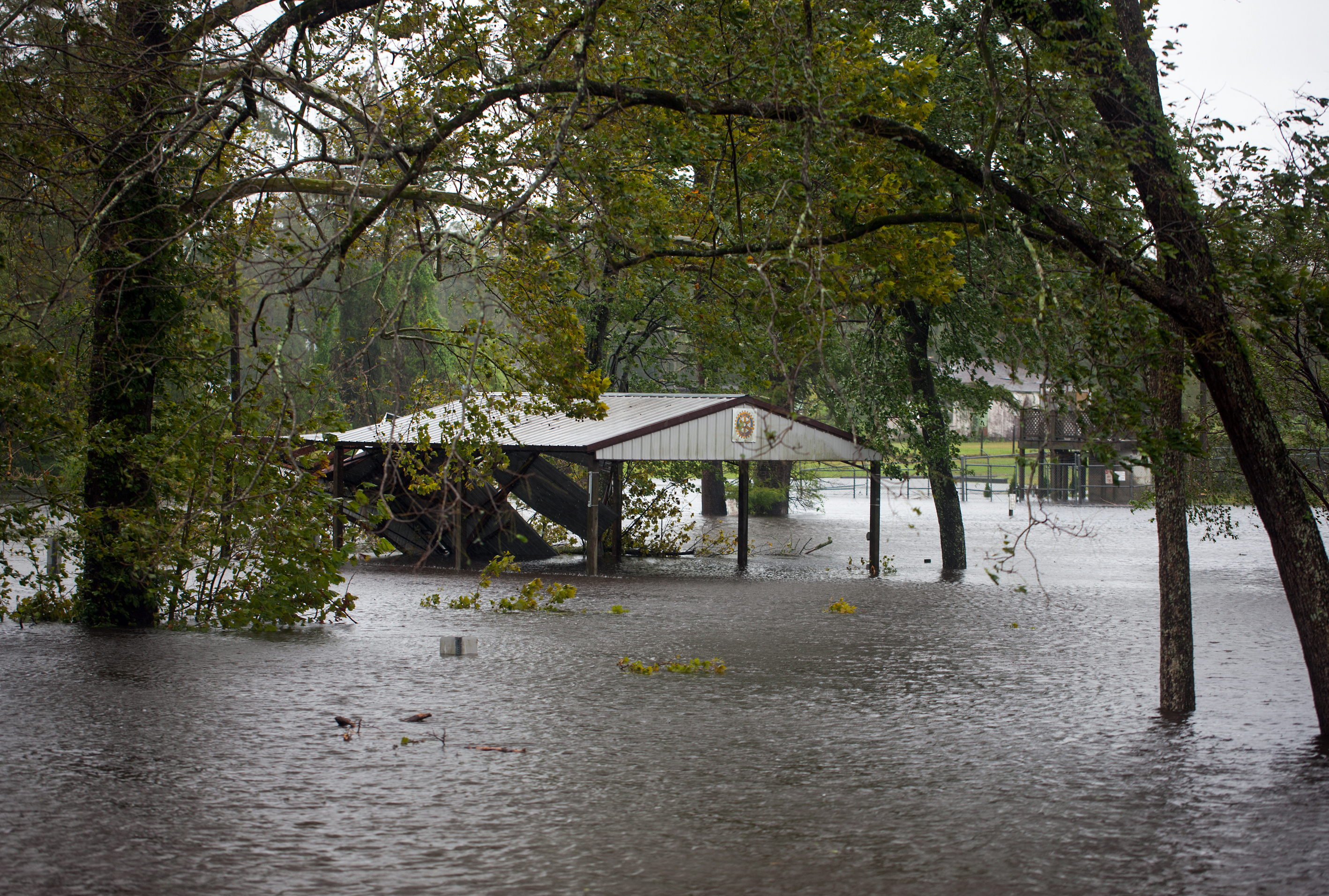Killer storm weakens, but officials warn devastation far from over
Flood waters from the Trent River inundate a park in Pollocksville, North Carolina (Logan Cyrus)
New Bern (United States) (AFP) – A killer storm that left up to 13 people dead weakened to a tropical depression on Sunday, but US authorities warned the devastation it caused — including catastrophic flooding — is far from over.
Most of the fatalities from Florence, which made landfall Friday as a Category 1 hurricane, have occurred in North Carolina, where officials confirmed eight victims. They included three who died “due to flash flooding and swift water on roadways,” the Duplin County Sheriff’s Office reported.
A woman and her baby were among the first casualties when a tree fell on their house, contributing to a death toll that US media said had reached 13 — 10 in North Carolina and three in South Carolina, according to CNN.
The National Hurricane Center (NHC) downgraded Florence to a tropical depression on Sunday morning, adding that “flash flooding and major river flooding will continue over a significant portion of the Carolinas.”
As of 5:00 am (0900 GMT) on Sunday, maximum sustained winds had weakened to near 35 miles (56 kilometers) per hour, the NHC said.
On Saturday, some residents tried to return home, driving through flooded highways and armed with chainsaws to clear fallen pine trees that covered the road.
North Carolina Governor Roy Cooper warned against such behavior as roads became increasingly dangerous.
– ‘Epic’ rainfall –
“All roads in the state right now are at risk of floods,” he said. “As rivers keep rising and rain keeps falling, the flooding will spread. More and more inland counties are issuing mandatory evacuations to get people to safety quickly.”
He earlier said the storm system “is unloading epic amounts of rainfall: in some places, measured in feet, not inches.”
Steve Goldstein of the National Oceanic and Atmospheric Administration (NOAA) said some areas have already received two feet of rain and could expect up to 20 inches more as the system moved “slowly, nearly stationary” over eastern North Carolina.
In New Bern, a riverfront city near the North Carolina coast that saw storm surges of up to 10 feet (three meters), residents took stock of the damage after flood waters began receding and authorities rescued hundreds of stranded people.
Charles Rucker, a retired teacher, had only spent five nights in his newly-purchased house, built in 1830, when Florence struck.
“It was like a bullet train coming through the living room. Nothing I ever experienced before, I was truly scared,” he told AFP.
“We have 4,200 damaged homes,” Mayor Dana Outlaw told CNN.
The doors of many houses suffered so much wind damage they appeared to have been kicked in, while the city’s beloved fiber-glass bear statues, which are sponsored by local businesses, were floating down streets.
However, authorities said 16 wild ponies on hurricane-struck Ocracoke Island, located off the North Carolina coast, were safe.
– Risk of tornados –
South Carolina Governor Henry McMaster on Saturday announced that a 61-year-old woman had died when her car hit a downed tree.
CNN also reported a man and a woman died in South Carolina’s Horry County due to carbon monoxide poisoning.
President Donald Trump tweeted late Saturday that “five deaths have been recorded thus far,” and expressed sympathy to the victims’ families.
The White House said Trump would visit hurricane-hit areas next week “once it is determined his travel will not disrupt any rescue or recovery efforts.”
More than 800,000 customers in North Carolina were without power and 21,000 people were being housed in 157 shelters across the state.
The military announced Saturday it was deploying nearly 200 soldiers to assist in storm response and recovery efforts, along with 100 trucks and equipment.
Besides federal and state emergency crews, rescuers were being helped by volunteers from the “Cajun Navy” — civilians equipped with light boats, canoes and air mattresses — who also turned up in Houston during Hurricane Harvey to carry out water rescues.
Hurricane Florence made landfall Friday in Wrightsville Beach, North Carolina, after stalking the coastline for days.
Tornadoes remain a threat, with the NHC saying that “a few tornadoes remain possible across North Carolina and eastern South Carolina.”
Disclaimer: This story has not been edited by Siliconeer and is published from a syndicated feed. Siliconeer does not assume any liability for the above story. Validity of the above story is for 7 Days from original date of publishing. Content copyright AFP.


